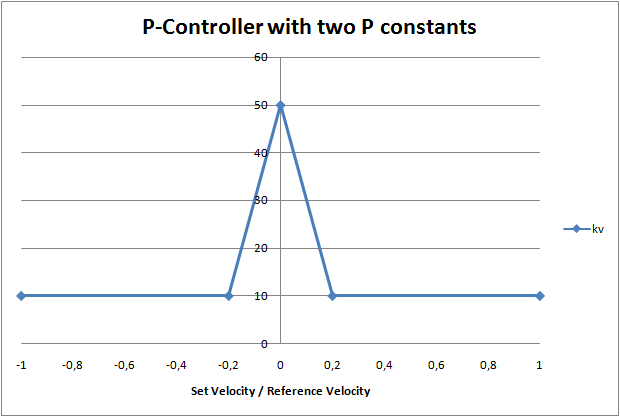Position Control Loop
A set velocity is transmitted to the drive controller via the fieldbus. The actual position of the axis is transmitted to TwinCAT as feedback via the fieldbus, creating a position control loop. The position control can be carried out using this circuit.
The position controller of the TwinCAT axis is only active if the drive controller is operated via the set velocity. If the drive controller is controlled via the set position, the position control loop in the drive controller is closed and must be parameterized there. The control parameters described here are then not effective.
Position control: Dead Band Position Deviation



The dead band position deviation defines a range in which the controller is inactive. This parameter is a symmetrical window based on the assumption that the position lag error with respect to the position control (position control deviation) within this window is zero. Position control is therefore disabled within the window.
This functionality is required because certain axes and mechanical systems may cause a stationary oscillation around the target position. The parameter can be used to enforce "calm". The parameterizable deviation around the exact target position is accepted.
There are axes that are not capable of position control or have insufficient holding torque around standstill, so that a certain inaccuracy around the target position is accepted.
For other real effects, such as pronounced static friction (with tear-off torque) or pronounced slack, dead band position deviation can also be used to enforce "calm" for an accepted accuracy.
Position control: Proportional Factor Kv



The Proportional Factor Kv is the proportional gain factor of the P part of the P controller. Output velocity = feed forward velocity + Kv * following error.
Position control: Proportional Factor Kv (standstill)



The Proportional Factor Kv (standstill) Kvs is the proportional gain factor of the P part of the P controller when the axis is stationary. Output velocity when stationary = feedforward velocity + Kvs * following error.
Position control: Proportional Factor Kv (moving)



The Proportional Factor Kv (moving) Kvf is the proportional gain factor of the P part of the P controller when the axis is moving. Output velocity when moving = feedforward velocity + Kvf * following error.
Position control: Velocity threshold V dyn [0.0 … 1.0]



With a PP controller, two P constants
- Kv (standstill)
Kvsand - Kv (moving)
Kvf
and a velocity threshold value vdyn define a function for a velocity-dependent control factor kv. If the value of the quotient "set velocity/reference velocity" is in the velocity threshold interval [- vdyn ... + vdyn], the gain factor of the P controller is linearly interpolated from the proportional factor Kv (moving) Kvf to the gain factor Kv (standstill) Kvs with zero velocity. The relationships are shown in the figure below.

The example was parameterized with Kvs = 50, Kvf = 10 and v_dyn = 0.2.
Position control: Integral Action Time Tn



Integral action time Tn of the I part of the PID controller. Integration time.
Position control: Derivative Action Time Tv



Derivative action time Tv of the real D part (D-T1 component) of the PID controller.
Position control: Damping Time Td



Damping time Td of the real D part (D-T1 component) of the PID controller.
Position control: Min./max. limitation I-Part [0.0 … 1.0]



Limitation of the I part of the PID controller.
Position control: Min./max. limitation D-Part [0.0 … 1.0]



Limitation of the D part of the PID controller.
Disable I-Part during active positioning



The I part of the PID controller can be disabled during active positioning.
Feedforward Acceleration: Proportional Factor Ka



The proportional factor Ka of the acceleration pre-control is the gain factor when a control with NC acceleration pre-control is used. Output velocity component = Ka * setpoint acceleration.
Further information about acceleration pre-control can be found in the section Acceleration Feedforward.
Feedforward Velocity: Pre-Control Weighting [0.0 … 1.0]



This parameter is a relative weighting of the pre-control. Here, the default parameter value 1.0 corresponds to a weighting of the pre-control of 100 %. The weighting of the velocity pre-control can be reduced to avoid overshooting in position.